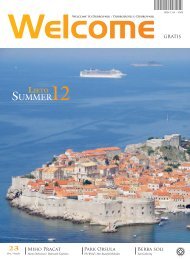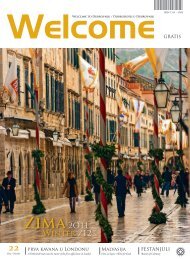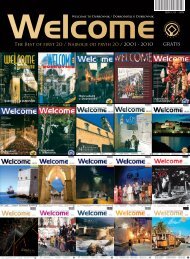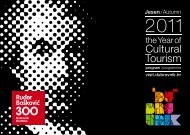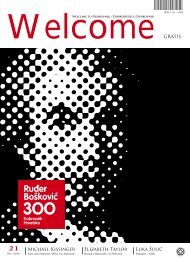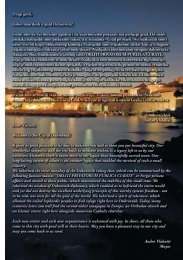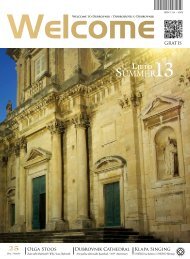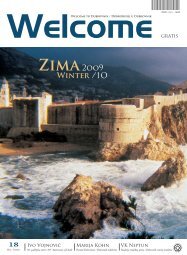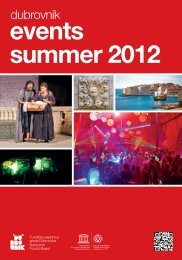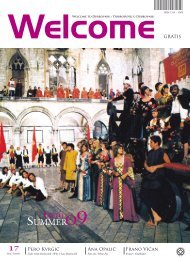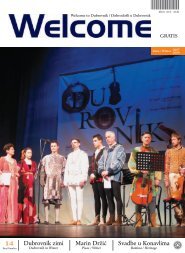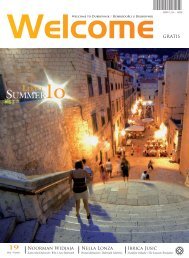24. Welcome to Dubrovnik - TuristiÄka zajednica grada Dubrovnika
24. Welcome to Dubrovnik - TuristiÄka zajednica grada Dubrovnika
24. Welcome to Dubrovnik - TuristiÄka zajednica grada Dubrovnika
Create successful ePaper yourself
Turn your PDF publications into a flip-book with our unique Google optimized e-Paper software.
Baština<br />
Muzej se sas<strong>to</strong>ji od tri dijela.<br />
U prvom dijelu ispričana je povijest<br />
židovske zajednice u proteklim<br />
s<strong>to</strong>ljećima š<strong>to</strong> je ilustrirano arhivskim<br />
ispravama. Drugi dio čuva izložene<br />
vjerske predmete vrlo visoke vrijednosti<br />
kao š<strong>to</strong> su svitci Tore nastali u razmaku<br />
od 13. do 17. s<strong>to</strong>ljeća podrijetlom iz<br />
Italije, Španjolske i Francuske, parohete<br />
s vezovima i čipkama, srebrne rimonime<br />
iz Venecije, menore i srebrni tasovi iz 17.<br />
s<strong>to</strong>ljeća kao i mnoštvo drugih predmeta<br />
koji su služili za vjerske obrede, a pomno<br />
su čuvani punih šest s<strong>to</strong>ljeća, koliko<br />
je zabilježeno i prisustvo Židova na<br />
ovom području. Osobita dragocjenost<br />
je maurski sag iz Španjolske iz 13.<br />
s<strong>to</strong>ljeća, te nekoliko tapiserija. Treći dio<br />
muzeja posvećen je žrtvama Holokausta<br />
s ispravama protužidovskih zakona i<br />
odredbi, kao i sačuvanim predmetima<br />
iz razdoblja velikih stradanja židovske<br />
populacije po cijeloj Europi.<br />
U ovo naše vrijeme kad<br />
<strong>Dubrovnik</strong> posjećuju rijeke turista,<br />
omiljeno im je mjes<strong>to</strong> upravo<br />
dubrovačka Sinagoga, dragulj među<br />
dubrovačkim povijesnim vrjednotama,<br />
sačuvan još od vremena kad su u <strong>to</strong>m<br />
kvartu zveckali dukati od trgovine<br />
koraljima, duhanom, kavom, cvali obrti<br />
slastičara, krojača, klobučara, knjižara,<br />
rađali se vrsni liječnici i pomorci, i svi<br />
zajedno u imućnoj Republici sv.Vlaha,<br />
pridonosili stvaranju temelja bogate<br />
i nadaleko poznate povijesne baštine<br />
<strong>Dubrovnik</strong>a.<br />
The streets of <strong>Dubrovnik</strong><br />
are arrayed on both<br />
sides of the Stradun like<br />
paintings, each with its own portrait,<br />
completely different from the others.<br />
One of them, stretching from the<br />
Stradun <strong>to</strong>wards Prijeko Street, used <strong>to</strong><br />
be called Lojarska Street because tallowcandles<br />
(lojanice) were once made there.<br />
It was later renamed Žudioska Street<br />
(Jewish Street) because of the ancient<br />
Synagogue located there. Namely, after<br />
the expulsion of the Jews from the<br />
Iberian Peninsula in the 15th century<br />
and their great migration all over<br />
Europe, a number of Sephardic Jews<br />
decided <strong>to</strong> settle down permanently in<br />
the <strong>Dubrovnik</strong> Republic. This happened<br />
in the 16th century when a homogenous<br />
Jewish community was established in<br />
<strong>Dubrovnik</strong>. The <strong>Dubrovnik</strong> authorities<br />
reached a final decision on the<br />
establishment of a ghet<strong>to</strong> within the<br />
city walls, <strong>to</strong> be more precise, close <strong>to</strong><br />
the City’s main street, the Placa, and<br />
near the Sponza Palace, where cus<strong>to</strong>ms<br />
procedures were carried out and goods<br />
were s<strong>to</strong>red.<br />
The ghet<strong>to</strong> initially consisted<br />
of four state owned houses and six<br />
s<strong>to</strong>rehouses, and the Jews paid rent<br />
<strong>to</strong> the <strong>Dubrovnik</strong> Cus<strong>to</strong>ms Office. A<br />
Jewish community was founded then,<br />
with a Synagogue located on the second<br />
floor of one of the houses. The facade of<br />
the Synagogue was in the Gothic style,<br />
while the interior was later designed in<br />
Italian Baroque style. During its many<br />
centuries of existence the Synagogue<br />
has housed many interesting details.<br />
Right above the entrance the skilful<br />
hand of a s<strong>to</strong>ne-cutter carved the<br />
following inscription a long time ago:<br />
„Blessed are you who enter “, while an<br />
inscription opposite the entrance, on<br />
the facade of the house across the road<br />
from the Synagogue reads: Blessed are<br />
you who leave“. For sure those turbulent<br />
and insecure times required words of<br />
comfort.<br />
Nowadays a museum,<br />
the Synagogue – as a major part of<br />
<strong>Dubrovnik</strong>’s his<strong>to</strong>ric heritage – houses<br />
an extremely valuable ancient and<br />
cultural inven<strong>to</strong>ry of the rich Jewish<br />
heritage. Its central part is vaulted<br />
with three arches. A Birnah is placed<br />
under the central arch, while the Aron<br />
HaKodesh encircled with massive<br />
wooden pillars stands at the eastern<br />
wall. On the southern and northern<br />
side one can see wooden bars secreting<br />
a room from which women could watch<br />
the religious ceremony. In the 19th<br />
century the room was replaced by a<br />
gallery on the western side.<br />
The museum consists of three<br />
sections. The first tells the his<strong>to</strong>ry of the<br />
28 Dobrodošli u <strong>Dubrovnik</strong> Zima 2012./13.



